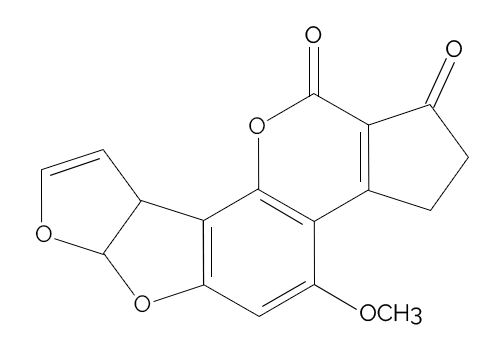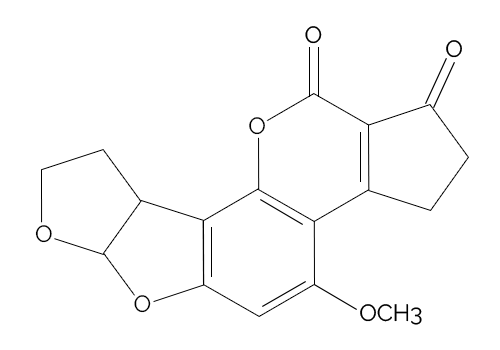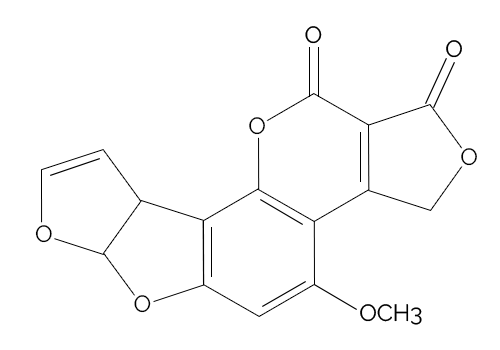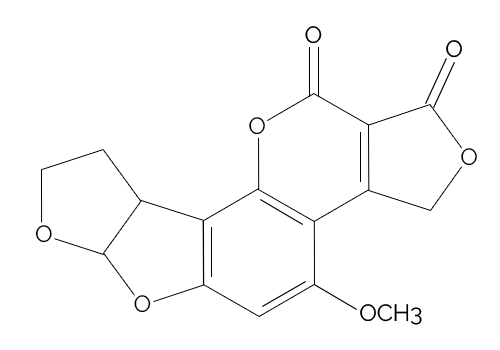
Several mycotoxins found in agricultural goods are a health risk to humans and animals and a financial issue. Mycotoxins are found naturally in foods, feeds, and the environment. Hepatotoxins, nephrotoxins, vomitoxin, and neuro-musculotoxin are the pathogenic classifications, and some of them are carcinogenic and mutagenic. Among mycotoxins, for example, aflatoxin is the most potent hepatocarcinogen and mutagen. As a result, mycotoxin contamination should be reduced by implementing a variety of preventative and control measures.
Humans and livestock are both at risk from aflatoxins. Aflatoxins are poisonous substances produced by certain types of fungi (molds) that can contaminate food crops and pose a serious health risk to humans and livestock. They are found naturally all over the world.
Nuts and grains are the primary sources of human exposure. Aspergillus flavus and Aspergillus parasiticus, two closely related fungi, are primarily responsible for producing aflatoxins of public health concern. These molds can infiltrate food crops under favorable conditions seen in tropical and subtropical locations, such as high temperatures and high humidity.
Drought stress, insect damage, and poor storage can all contribute to increased mold prevalence, even in more temperate climates.
The 4 Most Known Types of Aflatoxin?
There are 14 or more types of aflatoxin in nature, but four of them –B1, B2, G1, and G2 – are particularly dangerous to humans and animals because they have been found in all major food crops; however, the majority of human exposure comes from contaminated nuts, grains, and their derivatives.

AFLATOXIN B1

AFLATOXIN B2

AFLATOXIN G1

AFLATOXIN G2
Dietary exposure varies a lot.
Differences between developed and developing countries can be seen in national estimates of aflatoxins in the diet. Aflatoxin food exposures in affluent countries are typically less than 1 ng/kg body weight.
1ng/kg per day (a nano gram is one billionth of a gram), whereas estimates for some Sub-Saharan African countries exceed 100 ng/kg per day, even though these latter estimates are frequently based on very few data. Estimates of food exposure to AFM1 have seldom exceeded 1 ng/kg per day in any nation (but young children and breastfed newborns have been exposed to up to 6.5 and 8.8 ng/kg per day).
Long-term exposure can be harmful to one’s health.
- They are potent carcinogens that can affect all organ systems, especially the liver and kidneys; they cause liver cancer and have been linked to other types of cancer.
- Children may become stunted, although these data have yet to be confirmed because other factors such as low socioeconomic status, chronic diarrhea, infectious diseases, and malnutrition also contribute to growth faltering
- They cause immunosuppression, which may decrease resistance to infectious agents (e.g. HIV, tuberculosis)
Poisoning that occurs suddenly might be fatal.
Acute poisoning (aflatoxicosis) from large dosages of toxins can be life-threatening, usually due to liver damage. Since the 1960s, outbreaks of acute liver failure (jaundice, lethargy, nausea, and mortality), sometimes known as aflatoxicosis, have been reported in human populations. Aflatoxin-related deaths were most recently reported in the United Republic of Tanzania in the summer of 2016. Acute exposure tolerance is higher in adults than in youngsters.


Long-term exposure can be harmful to one’s health.
- They are potent carcinogens that can affect all organ systems, especially the liver and kidneys; they cause liver cancer and have been linked to other types of cancer.
- Children may become stunted, although these data have yet to be confirmed because other factors such as low socioeconomic status, chronic diarrhea, infectious diseases, and malnutrition also contribute to growth faltering
- They cause immunosuppression, which may decrease resistance to infectious agents (e.g. HIV, tuberculosis)
Poisoning that occurs suddenly might be fatal.
Acute poisoning (aflatoxicosis) from large dosages of toxins can be life-threatening, usually due to liver damage. Since the 1960s, outbreaks of acute liver failure (jaundice, lethargy, nausea, and mortality), sometimes known as aflatoxicosis, have been reported in human populations. Aflatoxin-related deaths were most recently reported in the United Republic of Tanzania in the summer of 2016. Acute exposure tolerance is higher in adults than in youngsters.

It’s difficult to detect aflatoxicosis in humans and animals.
Due to differences in clinical indicators and the existence of additional factors such as immune system suppression induced by an infectious condition, detecting aflatoxicosis in people and animals is difficult. The two most common techniques for detecting aflatoxins in humans are one that measures a breakdown product in urine (which is only present for 24 hours after exposure) and the other that measures the level of Aflatoxin contaminated nuts an AFB–albumin compound in blood serum, which provides information on exposure over weeks or months.
In epidemics where aflatoxin contamination is suspected, these biomarker measurements are critical.
For various demands, a range of aflatoxins detection methods in food and feed are available.
Aflatoxins are extremely important, and strategies for detecting and analyzing them have been widely investigated in order to develop highly specific, useful, and practical procedures. For various purposes, a variety of methodologies are available, ranging from regulatory control techniques/methods in official laboratories (such as HPLC-MS [high-performance liquid chromatography-mass spectrometry]) to fast test kits for industries and grain silos (such as ELISA [enzyme-linked immunosorbent assay]).
Dip-stick kits, hyperspectral imaging, electronic noses, molecularly imprinted polymers, and aptamer-based biosensors (small organic molecules that may bind specific target molecules) are all potential new aflatoxin-detection devices based on emerging technology. Because of their stability, ease of manufacture, and use, the latter technologies may be useful in remote places.
Procedures for sampling are troublesome
Because molds and aflatoxins are not evenly dispersed throughout bulk shipments and batches of stored grain, proper sampling is essential for obtaining an accurate result. In the context of regulatory control, protocols for sample methods have been devised. The Codex Alimentarius Commission, for example, has established the protocols to be used for peanuts, almonds, Brazil nuts, hazelnuts, pistachios, and dried figs intended for further processing as well as ready-to-eat almonds, Brazil nuts, hazelnuts, pistachios, and dried figs.
Recommended sampling methods are an issue, particularly for subsistence farmers in rural areas who do not produce enough grain to allow for proper testing. As a result, rapid, low-cost, low-technology, accurate aflatoxins detection technologies are needed to improve surveillance and management in rural regions. Organizations such as the Partnership for Aflatoxin Control in Africa and the World Food Programme are working to address these issues. For example, the World Food Programme created the Blue Box, which contains test kits for grain quality, including aflatoxins, to ensure grain quality.
How to prevent and control aflatoxins in dried food and nuts
Knowledge of mycotoxins’ fungal sources is required to develop strategies for reducing or eliminating them. The main cause of toxin generation and related to the concentration of harmful compounds is the growth of fungus in crops and agricultural goods. The production of mycotoxins is aided by a number of conditions. Plant vulnerability to fungi infection, fungal substrate appropriateness, temperate climate, moisture content, and physical damage to seeds caused by insects and pests are among them.
The toxin-producing fungus can invade throughout the growing season, harvest, post-harvest handling, and storage. Toxinogenic fungi are categorized into three types based on where they infest grains: (a) field fungi; (b) storage fungi; and (c) advanced degradation fungi. The first group contains plant pathogenic fungi of the genus Fusarium, such as Fusarium moniliforme, Fusarium roseus, Fusarium tricinctum, and Fusarium nivale. The “storage fungi” are mostly Aspergillius and Penicillium species, such as A. flavus and A. parasiticus.

Aflatoxin
Pistachio mold and damaged due to the Aflatoxin and Pest
If some fungi infect commodities early in their life cycle, level 2 protection will be required. To avoid future degradation and mycotoxin contamination, existing toxigenic-fungi should be eradicated or their growth halted. The following are some of the recommendations:
- Re-drying the products will stop the growth of affected fungi.
- Seeds that have been infected must be removed;
- Inactivation or detoxifying of tainted mycotoxins
- Stored materials should be kept away from any conditions that encourage fungus growth.
Both pre-harvest and post-harvest control methods are required. Enhancing the crop’s ability to resist fungal infection and/or prevent the invading fungus from producing aflatoxins is the most long-term, stable strategy for minimizing pre-harvest aflatoxin contamination. This can be accomplished by plant breeding or genetic engineering of the desired crops. These procedures, however, are time-consuming and labor-intensive. Pre-harvest intervention options that are effective, long-lasting, and universally applicable are required.
Preventive efforts to address suitable storage conditions (moisture, temperature, mechanical or insect damage, and aeration), which influence contamination and toxin development by mold, are included in post-harvest treatments. To eliminate aflatoxins from previously infected foods, further methods such as chemical decontamination or the application of enterosorbents might be used.
What consumers can do? How can you prevent consuming these toxins?
Molds do not merely grow on the surface of food; they also penetrate deep into it. To avoid being exposed to aflatoxins, consumers should:
- examine whole grains and nuts for signs of mold and discard any that appear to be moldy, discolored, or shriveled;
- Buy only reputable brands of nuts and nut jars of butter – aflatoxin molds are not completely killed by processing or roasting and can show up in products such as peanut butter;
- buy grains and nuts as fresh as possible; that have been grown as close to home as possible; that has not been transported over a long period of time
- Make sure goods are stored properly and aren’t kept for long periods of time before being used;
- attempt to eat a varied diet; this not only reduces aflatoxin exposure but also improves health and nutrition. Consumers with a limited dietary diversity must pay special attention to avoid high levels of aflatoxins exposure.




How to prevent pistachio mold?
Keep the product in a cold and dry place, in case of mold, use Aluminium Phosphide pills to prevent the spread.